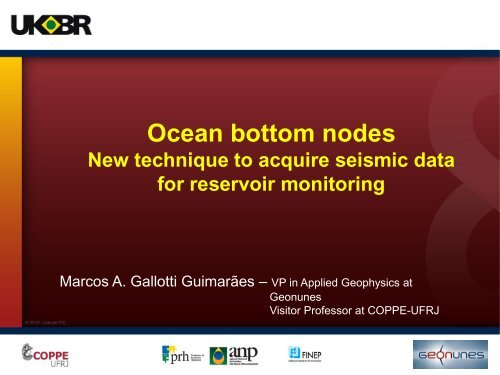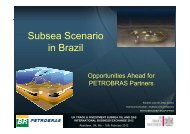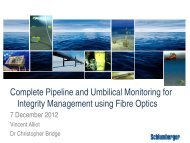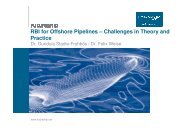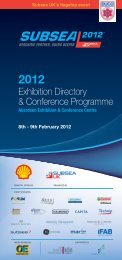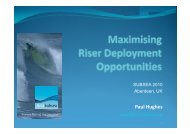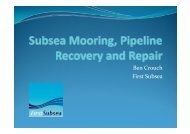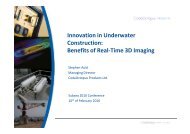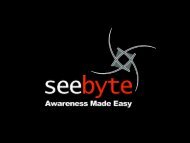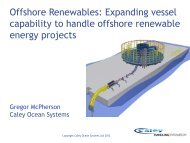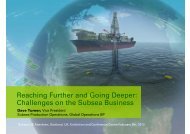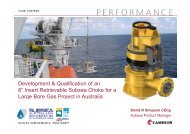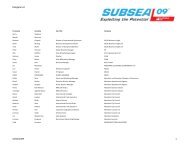Geonumes - Marcus Galloti - Subsea UK
Geonumes - Marcus Galloti - Subsea UK
Geonumes - Marcus Galloti - Subsea UK
Create successful ePaper yourself
Turn your PDF publications into a flip-book with our unique Google optimized e-Paper software.
Ocean bottom nodes<br />
New technique to acquire seismic data<br />
for reservoir monitoring<br />
Marcos A. Gallotti Guimarães – VP in Applied Geophysics at<br />
Geonunes<br />
Visitor Professor at COPPE-UFRJ
Conventional seismic acquisition with tow streamers<br />
Method utilized for O&G exploration since 70’s – 2D<br />
and 3D;<br />
Method utilized for Reservoir Characterization and<br />
Monitoring since 90’s – 3D and 4D;<br />
Method still utilized today for most of the projects in<br />
O&G E&P.
2D seismic acquisition principle
3D seismic acquisition principle
3D seismic acquisition principle
4D seismic principle
3D seismic issues
Subsalt illumination issues
4D issues
Non-conventional seismic acquisition with<br />
Ocean Bottom Cables - OBC
Non-conventional seismic acquisition with<br />
Ocean Bottom Cables - OBC<br />
Method utilized mainly for reservoir<br />
characterization and monitoring;<br />
Seismic Source detached from the Receivers;<br />
• More flexibility to acquire on obstructed<br />
areas<br />
Receivers in OBCs coupled on the sea floor;<br />
• Capability to acquire the shear wave<br />
Wide azimuth data acquisition
Ocean Bottom Cables – OBC<br />
Flexibility to operate on production infra-structure
Ocean Bottom Cables – OBC<br />
Record the shear wave
Ocean Bottom Cables – OBC<br />
Wider azimuths collected than tow streamer
OBC issues<br />
Water depth capability only up to 1000m;<br />
Wide not Full azimuth;<br />
No flexibility on under water infra-structure;<br />
Sensors on the sea floor not coupled well for<br />
shear wave record.
OBC issues – wide but no Full
OBC issues – no flexibility on subsea infrastructure
Oceanic Nodes
Oceanic Nodes<br />
Method utilized mainly for reservoir<br />
characterization and monitoring;<br />
• Ultra deep water capability up to 3000 m<br />
• Sub sea infrastructure<br />
• High repeatability<br />
Seismic Source detached from the Receivers;<br />
• More flexibility to acquire on obstructed<br />
areas
Oceanic Nodes<br />
Full Azimuth data for sub salt sediments<br />
imaging<br />
Receivers well coupled on the sea floor;<br />
• Capability to acquire the shear wave<br />
• No vector fidelity issues<br />
• Fracture reservoir detection
Flexibility over ultra deep water subsea infrastructure
High Repeatability in the receiver positions for 4D<br />
monitor surveys
One Vessel crew
Full Azimuth Capability for sub salt imaging
3- components receivers well coupled
Shear wave and Z component P wave better recorded
Existing units<br />
OYO Geospace<br />
CGGVeritas<br />
Fairfieldnodal<br />
Fugro
Oceanic Nodes issues<br />
Non conventional data processing;<br />
Battery life time;<br />
Efficiency in deployment and recovery;<br />
Availability of nodes in the market;<br />
Three nodes crew available in the market;<br />
Geophone low frequency;
Non conventional data processing<br />
Project conducted by Geonunes/Petrec/FINEP<br />
• Sparse receivers Imaging;<br />
• Sparse receiver velocity analysis;<br />
• Converted wave processing;<br />
• Nodes data pre-processing;
Market situation<br />
Shell predicts: 50% of all offshore seismic will be with<br />
nodes within 10 years<br />
100% of Shell’s surveys during 2011/2012 in the Gulf<br />
of Mexico was with nodes (Fairfield).<br />
Total seeks a multi year contract with a node provider<br />
for the North Sea and Nigeria (3000 sq.km)<br />
BP seeks a node provider for surveys for the North<br />
Sea and probably Gulf of Mexico
Market situation<br />
Agbami field (Nigeria) has two 4D monitors with<br />
nodes;<br />
Seabed (Fugro) is acquiring a monitor survey with<br />
nodes in Frade field (Campos basin);<br />
Two surveys with nodes for sub-salt sediments in<br />
Atlantis field, GofM.
Brasil situation<br />
Pos-salt fields being developed with 4D seismic are<br />
fully obstructed on the sea floor, e.g. Marlim,<br />
Albacora, Marlim Leste, Roncador, Parque das Baleias,<br />
etc.<br />
Fracture detection in fracture reservoir (Marlim<br />
Leste);<br />
All the above fields are located in deep water and<br />
ultra deep water.<br />
Pre-salt fields require full azimuth data to<br />
characterize the sediments below salt domes
Project proposal<br />
Develop a node of reduced size as compared to<br />
existing similar system<br />
Implementation of low frequency geophones<br />
Long battery lifetime ( 150-200days)<br />
Next generation of high accuracy clocks ( low power<br />
consumption)
Brasil situation<br />
Focus on a large number of small sized planted<br />
nodes of higher operational efficiency<br />
Flexible solutions for different types of surveys ,<br />
sizes and water depths<br />
Develop a permanent node system using the<br />
same building blocks<br />
A fully integrated company, offering acquisition,<br />
processing and interpretation
Thank you !<br />
Marcos Gallotti Guimarães<br />
gallotti@geonunes.com


